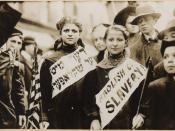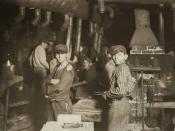AbstractAlthough working the labor of a youngster was a worldwide epidemic, the United States (US) had its share of placing children in this harsh environment. Taken away from most sources of education, child labor in itself helped industry thrive, but at the same time, stunted a time of social growth in America. This paper will attempt to bring from the past a glimpse of what once was and what now is, and the very thing that saved America from harboring the inessential and objectionable need for laboring of the lambs.
Laboring the LambsEvolution of Child LaborThe bustling strength of the Industrial Revolution brought forth the need to increase the labor forces throughout America. Normally situated on farms where work was seemingly hard and cashed in little money for the labor, families were lured to the ever-growing industrial development in urban areas to seek a steady pay provided by factories and other industrial enterprises (Clark-Bennett, Hodne, & Sherer , 2000).
As factories boomed, so did the need for labor, and industrial managers sought the need to harness the easiest labor available to them-the child. Management of these industrial sweatshops viewed child labor as cheap, manageable, and not deemed to strike as adults might (Clark-Bennett et al., 2000).
Causes of Child LaborThe history of child labor stems back to the early 1800s' and escalated in the early 1900's (Clark-Bennett et al., 2000). Other than the simplicity of picking a child from the fields, there are several notable causes of child labor.
1.Poverty - families in survival modes found it hard to resist the temptation of sending their child to work in order put food on the table (Clark-Bennett et al., 2000).
2. Inadequate Education Facilities - In many parts of America, school facilities were less than adequate, meaning that working was...


